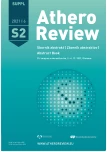33PS Endoglin blockage is essential in hypercholesterolemia and hyperglycemia induced endothelial dysfunction in HAECs
33PS Endoglin blockage is essential in hypercholesterolemia and hyperglycemia induced endothelial dysfunction in HAECs
Introduction: It has been demonstrated that exposure of endothelial cells to hypercholesterolemia and hyperglycemia leads to increased levels of endoglin and cell adhesion molecules, as well as increased adhesion and transmigration of monocytes through endothelial monolayer. Carotuximab (TRC105), a monoclonal antibody that binds to endoglin, was originally developed for the use in oncology. However, there are no studies available to elucidate potential role of carotuximab treatment on Eng expression, signaling and function with respect to endothelial dysfunction development and/or prevention. Aim: Therefore, in this study, we hypothesized that carotuximab treatment prevents 7-ketocholesterol and hyperglycemia induced development of endothelial dysfunction by direct effect on Eng expression, signaling and function. Material and Methods: Human aortic endothelial cells (HAECs), passage 5, were cultured in EGM-2 media with appropriate supplements and 10% FBS until reaching 80% confluence. In hypercholesterolemia studies, cells were treated with carotuximab (300 µg/mL) for 1 hour, followed by addition of 7-ketocholesterol (10 µg/mL) for another 12 h. In hyperglycemia studies, cells were exposed to high glucose (45 mM) for 60 hours, followed by addition of carotuximab for another 12 hours and cells treated with 5 mM glucose and 40 mM mannitol served as osmotic control. Gene expression was measured by qRT-PCR. Protein levels, adhesion and transmigration of monocytes were assessed by flow cytometry. Results: Carotuximab pretreatment reduced endoglin protein expression and signaling in both hypercholesterolemia and hyperglycemia induced endothelial dysfunction. Despite increased expression of cell adhesion molecules carotuximab blockage of endoglin prevented increase of adhesion and transmigration of monocytes through endothelial monolayer in both hypercholesterolemia and hyperglycemia induced endothelial dysfunction. Conclusion: These results suggest that carotuximab-mediated endoglin blockage is essential in hypercholesterolemia and hyperglycemia induced endothelial dysfunction in HAECs and therefore that endoglin might be an interesting therapeutical target in diseases characterized by elevated cholesterol and glucose.
Autoři:
Tripska K 1; Igreja E Sá Ic 1; Vicen M 1; Havelek R 2; Eissazadeh S 1; Vitverová B 1; Nachtigal P 1
Působiště autorů:
Department of Biological and Medical Sciences, Faculty of Pharmacy in Hradec Kralove, Charles University, Czech Republic
1; Department of Medical Biochemistry, Faculty of Medicine in Hradec Králové, Charles University, Czech Republic
2
Vyšlo v časopise:
AtheroRev 2021; 6(Supplementum 2): 23
Kategorie:
Posterová sekce
Souhrn
Introduction: It has been demonstrated that exposure of endothelial cells to hypercholesterolemia and hyperglycemia leads to increased levels of endoglin and cell adhesion molecules, as well as increased adhesion and transmigration of monocytes through endothelial monolayer. Carotuximab (TRC105), a monoclonal antibody that binds to endoglin, was originally developed for the use in oncology. However, there are no studies available to elucidate potential role of carotuximab treatment on Eng expression, signaling and function with respect to endothelial dysfunction development and/or prevention. Aim: Therefore, in this study, we hypothesized that carotuximab treatment prevents 7-ketocholesterol and hyperglycemia induced development of endothelial dysfunction by direct effect on Eng expression, signaling and function. Material and Methods: Human aortic endothelial cells (HAECs), passage 5, were cultured in EGM-2 media with appropriate supplements and 10% FBS until reaching 80% confluence. In hypercholesterolemia studies, cells were treated with carotuximab (300 µg/mL) for 1 hour, followed by addition of 7-ketocholesterol (10 µg/mL) for another 12 h. In hyperglycemia studies, cells were exposed to high glucose (45 mM) for 60 hours, followed by addition of carotuximab for another 12 hours and cells treated with 5 mM glucose and 40 mM mannitol served as osmotic control. Gene expression was measured by qRT-PCR. Protein levels, adhesion and transmigration of monocytes were assessed by flow cytometry. Results: Carotuximab pretreatment reduced endoglin protein expression and signaling in both hypercholesterolemia and hyperglycemia induced endothelial dysfunction. Despite increased expression of cell adhesion molecules carotuximab blockage of endoglin prevented increase of adhesion and transmigration of monocytes through endothelial monolayer in both hypercholesterolemia and hyperglycemia induced endothelial dysfunction. Conclusion: These results suggest that carotuximab-mediated endoglin blockage is essential in hypercholesterolemia and hyperglycemia induced endothelial dysfunction in HAECs and therefore that endoglin might be an interesting therapeutical target in diseases characterized by elevated cholesterol and glucose.
Štítky
Angiologie Diabetologie Interní lékařství Kardiologie Praktické lékařství pro dospěléČlánek vyšel v časopise
Athero Review

2021 Číslo Supplementum 2
Nejčtenější v tomto čísle
- 08ÚS Multifaktoriální chylomikronemie
- 09ÚS Post mortem vyšetření náhlé srdeční smrti: výstupy
- 26PS Využití chytrých hodinek ke kardiorehabilitaci pacientů po infarktu myokardu: pilotní výsledky studie SmartRehab.
- 15ÚS Zkušenosti s léčbou lomitapidem u pacientů s homozygotní familiární hypercholesterolemií
